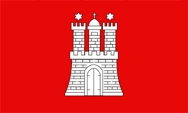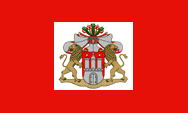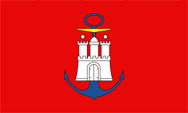


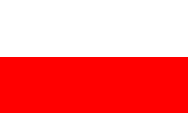
14th, 15th, 16th cent.,
Colours of the Hanse,



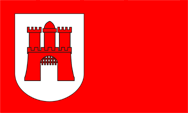
15th–16th cent.,
Flag of Hamburg,
Source, by: Flags of the World



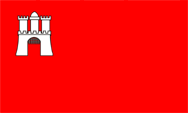
17th cent.,
Flag of Hamburg,
Source, by: Flags of the World



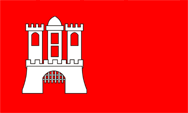
17th cent.,
Flag of Hamburg,
Source, by: Flags of the World



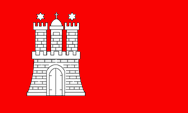
18th–19th cent.,
Flag of Hamburg,
Source, by: Flags of the World



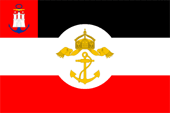
1893–1921,
Official flag offshore,
ratio = 2:3,
Source, by: Flags of the World



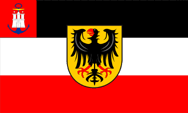
1921–1933,
Official flag offshore,
ratio = 3:5,
Source, by: Flags of the World



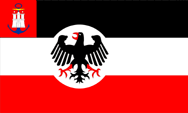
1933–1934,
Official flag offshore,
ratio = 3:5,
Source, by: Flags of the World




The flag of Hamburg is a scutcheon-flag, and shows exactly like the coat of arms or the seal, always a castle with three towers and a gate. The flag was usually always red, and showed a white castle, or even a red castle on a white shield. Even in the 13th Century they have been used even a just plain red flag with no castle. However, it is also reported about white flags, or even blue flags, which should have been used rare, and certainly had served for specific purposes. Because white and red are the colors of the city, and also the colors of the Hanseatic League, in which Hamburg was a powerful member for over 300 years.
The castle was shaped over the times in very different versions, once it showed masonry, sometimes not, sometimes the castle was extremely stylized, sometimes not, sometimes the door was open, sometimes closed. Apparently there had been no uniform rules. Normally, the open gate should show the right of the landlord (the Counts of Holstein), that it is him everytime allowed to enter the city. On vessels was frequently a variant in use, which had moved the eagle more toward the mast to allow a proper identification of the ship during week winds.
In 1624 the Hamburg Admiralty was established to administer pilotage, the war and accompanying ships. Even in the 17th Century the Admiralty got their own coat of arms and their own flag. It shows how the Hamburg flag, a red bunting, on it in the center a blue anchor, on it placed the Hamburg castle. The flag is still used only by maritime authorities, hoisted on ships and boats as a jack, or on buildings of the authorities. This can be bridges, port supervisors, or the Port Building Department. There exist also variants with a black anchor.
Since 1897 there is a state flag. It is reserved for the Senate as head of state and shows the greater coat of arms on a white rectangle on red background. It is hoisted during the presence of the Senate at the Town Hall or for representative occasions on vessels when there are members of the Senate on board.
Interesting is even the offshore official flag. This flag was introduced in 1893, in the design of the official flags for all the coastal states of the German Empire, to ensure a uniform appearance of the authorities at sea. It corresponded to the imperial black-white-red naval official flag of the German Empire, and differed by country only by a coat of arms, shown in the upper corner of the flag. Three years after the abdication of the emperor was introduced a new offshore official flag, which corresponded and showed again the black-white-red naval official flag of the German Empire (this time with the national emblem in the middle), and had also the locale heraldy in the upper canton.
In 1933, the National Socialists seized power in Germany, which was to be noticeable in a transitional phase until 1934, in the appearance of many coats of arms and flags. On the official flag now was in use a representation of the imperial eagle, as it could be seen on the flag of the President. The eagle was placed – with no shield, just on a white plate – a little bit out of the center moved toward the flagpole. For the National Socialists, the federal structure of the German Empire, its historically grown countries, was considered as outdated, as relics of a past to be overcome. In this sense, several laws were enacted, on 31st of March in 1933 the 'Provisional Law for the phasing of the countries with the Empire', on 7th of April 1933 the 'Second Law for the phasing of the countries with the Empire' and finally, on 30th January in 1934 the 'Law on the rebuilding of the empire'. Thus, the federal structure of the German Empire was replaced by the gau-structure of the NSDAP, the countries became meaningless. From now on, offices and authorities had to use the swastika flag as official flag, until September 15th in 1935, when by the flag-law was legislated a new created official flag for all the offices and authorities of the empire. The prime ministers of the countries, which latest in 1933 all came from the NSDAP – now mostly called Reichsstatthalter (maybe translated as 'governor') – however remained in office until 1945. The corresponding country colours continued, with restrictions, but definitly not in the form of flags. They were used, for example, occasionally on uniforms of the SA or in some ranks of the Hitler Youth in the breast cord.
After the war, the administration within the German Empire was rebuilt, but locally, following the structure of the countries. These have been partly old countries, and some new countries were created. Sometimes they bethought the old country colours and reactivated them – or they created new ones – for limited sovereign duties, which were under the control of the Allies. Hamburg was founded as a coutry again in 1946, and became in 1949 a part of the FRG. In principle, the flags prior to 1893 were re-introduced.
Source:
Flags of the World,
Wikipedia (D),
World Statesmen,
Volker Preuß,
Jürgen Kaltschmitt,
Uniform-Fibel

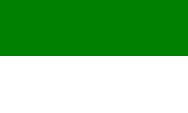
Flag of Bergedorf,
Source, by: Flags of the World



The place Bergedorf was originally in the possession of Saxony-Lauenburg. In 1420 Hamburg and Lübeck troops attacked the city and captured it. In the Peace of Perleberg the place comes under a joint administration of Hamburg and Lübeck in 1420. This administration existed to 1st of January in 1868, as Bergedorf came by buying in solely possession of Hamburg. Bergedorf is remarkable, because the place was allowed to issue its own stamps in 1861.
However, the currency was the Mark of Hamburg. In 1938 it became a district of Hamburg.
Source:
Historisches Deutschland,
Der Michel,
Wikipedia (D)


Escutcheon-logo of Hamburg,
Source, by: Wikipedia (D)

lesser coat of arms of Hamburg,
Source, by: Wikipedia (D)
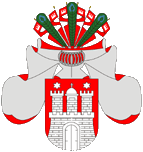
middle coat of arms of Hamburg,
Source, by: Wikipedia (D)
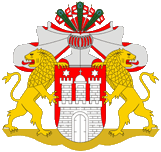
greater coat of arms of Hamburg,
Source, by: Wikipedia (D)

The coat of arms of Hamburg showed exactly how the oldest seal of 1245, always a castle with three towers and a gate. Today the shield is red, and shows a white castle. White and red are the colors of the city, and also the colors of the Hanseatic League, in which Hamburg was a powerful member for over 300 years. The castle was shaped over the times in very different versions, once it showed masonry, sometimes not, sometimes the castle was extremely stylized, sometimes not, sometimes the door was open, sometimes closed. Apparently there had been no uniform rules. Normally, the open gate should show the right of the landlord (the Counts of Holstein), that it is him everytime allowed to enter the city. The use of the arms is very strictly limited. The use is only allowed for official departments. Individuals may actually use only the escutcheon-logo of the city (look above).
Source: Wikipedia (D),
Volker Preuß


to 1919, Cockade of Hamburg

read here:
Informations, history and facts about the theme "Cockades".

Cockade

FRG and its countries, clickable map:
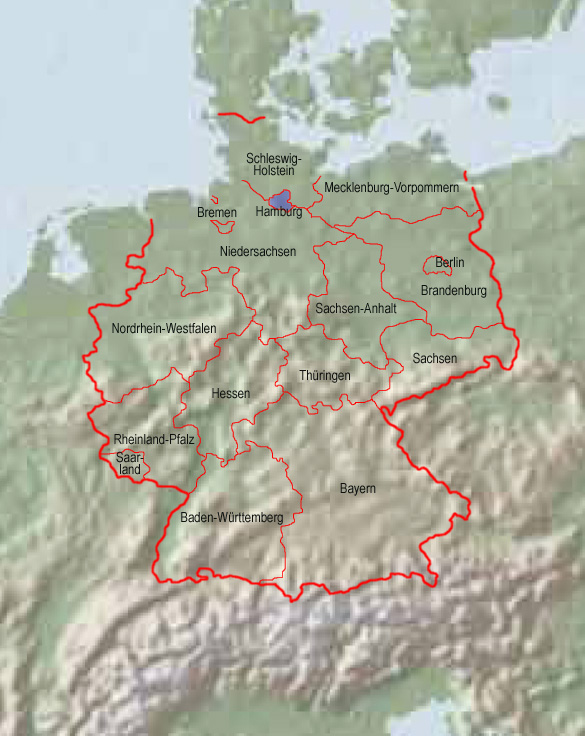
Source: Volker Preuß
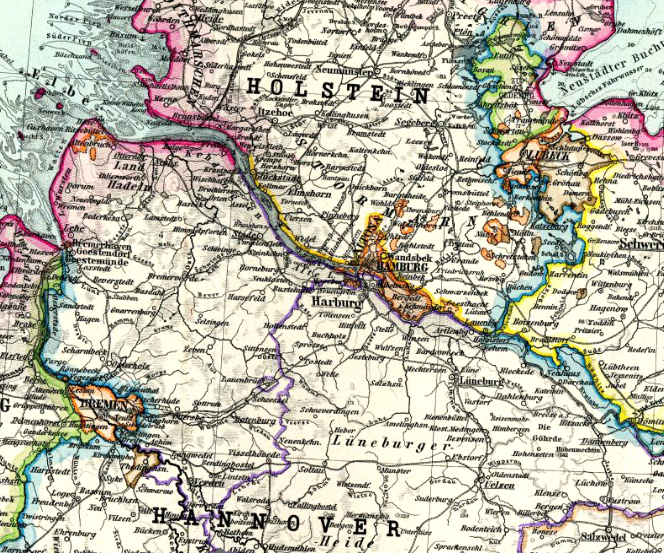
Source: Stielers Hand-Atlas, Justus Perthes, 1891
The map shows the Hanseatic Cities of Bremen, Hamburg and Luebeck around 1890 within an orange colored border. The border of the German Empire is hatched in red, the Prussian in blue, the border of Mecklenburg-Schwerin in yellow, the border of Mecklenburg-Strelitz in brown, and the border of Oldenburg in green.

Area: 292 square miles
Inhabitants: 1.796.000 (2011)
Density of Population: 6.159 inh./sq.mi.
Religions: 32% Protestant, 10% Roman Catholic
Capital: Hamburg is a city state
official Language: German
other Languages: Low German
Currency to 1876: 1 Mark Courant = 16 Schillinge
Currency 1868–1871: 1 Taler = 30 Silbergroschen = 360 Pfg.
Currency 1871–1924: 1 Mark = 100 Pfennig
Currency 1924–1948: 1 Reichsmark (RM) = 100 Reichspfennig (Rpf.)
Source:
Wikipedia (D),
Der Michel

about Christ's birth · the Romans know a settlement called "Treva" on the Alster River
4th–6th century · settlement by Saxons
6th century · invasion of the Slavic tribes of the Obodrites and Wilzen
772–804 · conquest of Saxony by the Franks under Charlemagne, Christianization
808 · first construction of the Hammaburg (Hamma Castle) between the rivers Alster and Bille (later destroyed from the Slavic tribe of the Wilzen)
810 · second construction of the Hammaburg
831 · Hamburg becomes a Diocese
834 · Hamburg becomes a Archdiocese
845 · destroyed by the Normans
848 · the Archdiocese of Hamburg is united with the diocese of Bremen, the Archbishop of Hamburg moved its headquarters to Bremen
959 · Hermann Billung is Duke of Saxony
983 · Slavs revolt, the region falls back to the Slavs
987 · recapture
1072 · Slavs attack, destruction, Hamburg becomes a Diocese again
1110 · Holstein (landscape in the north of Elbe River) comes to the counts of Schauenburg
1189 · Hamburg becomes a free town (without feudal lord), with its own jurisdiction, duty rights and fishing rights, governed by a council, the counts of Holstein may only establish a Vogt (Approved 1292)
1201 · victory of the Danes under Valdemar of Schleswig over Count Adolf of Holstein, Hamburg comes under a Danish governor
1225 · Hamburg comes back the Count Adolf IV. of Schauenburg
1302 · Hamburg receives duty-free-right
1356 · joining to the Hanseatic League (until 1669)
1393 · Hamburg acquires the fortress Ritzebuettel with Cuxhaven and Neuwerk Island
1460 · King Christian I. of Denmark inherits the possessions of Schauenburg and tries to get hold of the city
1510 · Emperor Maximilian I., makes Hamburg (to protect it against Denmark) to an Free Imperial City, status confirmed in 1618 and in 1648
1521 · spread of the Lutheran Reformation
1529 · introduction of the Reformation
1618–1648 · Thirty Years' War, Hamburg is spared
1629 · Hamburg, Bremen and Luebeck join together in the Hanseatic Community
1685 · the Danes try to get hold of the city one more
1712 · King Frederick IV. of Denmark tries to get hold of the city
1768 · Treaty of Gottorp, declaration of Hamburg's independence against Holstein (Danish) claims
1770 · Hamburg receives a seat and a vote in the Reichstag
1792, 1796, 1800 and 1805 · invasions of French revolutionary troops under Napoléon (from 1804 Emperor of France) in the German Empire
1801 · short invasion of the Danes in Hamburg, under Prince Charles of Hesse
1803 · German Mediatisation (Reichsdeputationshauptschluss), the German Empire becomes transformed territorially by Napoleon: ecclesiastical possessions become confiscated, old princely territories become repealed and transferred to old or new principalities, Hamburg purchases the Dome area
1806 · Hamburg is occupied by French troops
1st of August in 1806 · end of the Holy Roman Empire of German Nation under pressure of Napoleon, the emperor retires
13th of November in 1806 · the city calles itself 'Free Hanseatic City of Hamburg'
19th of November in1806 · Hamburg is occupied by French troops
13th of Dezember in 1810 · Hamburg becomes annexed by France (until 18th of March in 1813)
18th of March in 1813 · Russian troops under General Tettenborn free Hamburg, the city calles itself again 'Free Hanseatic City of Hamburg'
29th of May in 1813 · reconquest by French troops, Hamburg is once again annexed by France (until 31st of May in 1814)
October 1813 · defeat of Napoleon at Leipzig
May 1814 · the French troops surrender the city, withdrawal of the French
1814–1815 · Congress of Vienna, reorganization of Europe after the Napoleonic era, Hamburg becomes again Free and Hanseatic City (31th of May in 1814) and joins the German Confederation (8th of June in 1815)
20th of Dezember in 1819 · Hamburg calles itself now 'Free and Hanseatic City'
1831 · cholera epidemic
1842 · great fire
23rd of May in 1850 · Hamburg gets a constitution
16th of February in 1855 · new constitution
1st of January in 1861 · new Constitution
29th of June in 1866 · withdrawal from the German Confederation, Hamburg becomes an ally of Prussia
1866–1867 · Fratricidal War (German War), defeat of Austria and its allies against Prussia and its allies (including Hamburg)
15th of May in 1867 · Hamburg joins the North German Confederation
23rd of July in 1867 · Military Convention, the defense ressort goes to Prussia
1st of January in 1868 · Bergedorf becomes the solely possession of Hamburg
1871 · Hamburg becomes a state of the German Empire
October 1923 · 'Hamburg Uprising', a failed communist coup
1933–1934 · Hamburg cedes (like all German states) its exclusive pilitical rights to the government of the empire, the territorial structure of the German Empire countries become replaced by the Gau structure of the NSDAP, the countries become meaningless, finally on 30th January in 1934 by the 'Law on the rebuilding of the empire'
26th of January in 1937 · Greater Hamburg Act, Hamburg becomes combined with Altona, Harburg and Wandsbeck to 'Greater Hamburg', it has to cede the exclaves Geesthacht, Großhansdorf and Schmalenbeck, and has to cede Ritzebuettel and Cuxhafen and the islands of Neuwerk and Scharhoern
1st of April in 1938 · calles itself 'Hanseatic City of Hamburg'
1939–1945 · World War II, July/August 1943: British heavy bombardments bring the death to 40.000-50.000 civilists, 30% of the residential areas will be destroyed; British troops occupy Hamburg on 3rd of May in 1945
15th of May in 1946 · reestablish of the State of Hamburg
7th of September in 1949 · Hamburg becomes a state of the FRG
6th of June in 1952 · Hamburg calles itself again 'Free and Hanseatic City'
16th/17th of February in 1962 · storm surge demands over 300 dead people
1969 · state-treaty between Lower Saxony and Hamburg, the islands of Neuwerk and Scharhoern become affiliated with Hamburg again
Source:
RetroBib Retrobibliothek,
Wikipedia (D),
Historisches Deutschland,
World Statesmen,
Jürgen Kaltschmitt

The name "Hamburg" goes back to the word "Hammaburg" first documented in 832. The Hammaburg was probably a fortified place on a "Hamme", a moraine slope, which is surrounded on three sides by marsh or swamp, and so well protected. Other sources refer Hammaburg to "Burg (castle) on the Hamme", which means with "Hamme" a boundary forest. The location of the castle is suspected in the area of the present-day Cathedral Square.
Source: Wikipedia (D),
Historisches Deutschland







![]()

